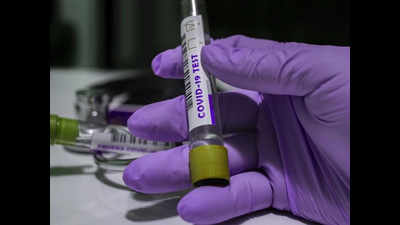- News
- City News
- bhubaneswar News
- Celsius rise leads to virus dip: IITBBS study
Trending
This story is from July 13, 2020
Celsius rise leads to virus dip: IITBBS study
In the study, the researchers found that an increase in relative humidity tends to decrease the growth rate and doubling time by 1.18 days.

Representative image
BHUBANESWAR: A study conducted jointly by researchers at the Indian Institute of Technology (IIT) Bhubaneswar and the All India Institute of Medical Sciences (AIIMS) here has found that the spread of the novel coronavirus weakens with an increase in temperature and relative humidity.
The study titled 'Covid-19 spread in India and its dependence on temperature and relative humidity', which is in its pre-print stage, has established that an increase in temperature leads to a decrease in the spread of the life-threatening virus.It says that a one degree Celsius rise in temperature leads to a 0.99 decline in cases and increases the doubling time by 1.13 days.
Dr V Vinoj, assistant professor at the School of Earth, Ocean and Climate Sciences in IIT Bhubaneswar, who led the study, said, "We have taken the period from April to June and found that surface temperature is closely related to the spread of Covid-19. But in case of humidity, we find the relationship weak over India unlike global studies that have shown an inverse between humidity and disease cases."
In the study, the researchers found that an increase in relative humidity tends to decrease the growth rate and doubling time by 1.18 days. They, however, maintained that since the study period excluded the period of high humidity, which usually occurs between the monsoon and the onset of winter, more research needs to be done to ascertain its impact.
Vinoj said they have also analysed the impact of solar radiation on the virus and found that an increase in solar radiation decreases the disease cases and increases their doubling time. "There is an average difference of seven degrees Celsius from summer to winter. Given the current understanding, it is possible that the cases may rise in winter," he said.
He added that in a statistical analysis of the mean covid cases per population ratio between countries based on hemispheric locations, it has been found that the countries in the northern hemisphere have higher cases than those in the southern one. He further said apart from environmental factors, the enforcement measures also play a key role in containing the spread of the virus.
The researchers said taking the outcomes of the study into consideration, there is a possibility of an increased spread of the Covid cases during the peak of monsoon and winter, if the current situation prevails. The study aims to help the policymakers come up with preventive measures, Vinoj added.
Besides Vinoj and Behera, N Gopinath and K Landu from the School of Earth, Ocean and Climate Sciences in IIT Bhubaneswar and B Mishra from the department of microbiology from AIIMS Bhubaneswar also took part in the study. The study is currently under review and is in its pre-print version.
The study titled 'Covid-19 spread in India and its dependence on temperature and relative humidity', which is in its pre-print stage, has established that an increase in temperature leads to a decrease in the spread of the life-threatening virus.It says that a one degree Celsius rise in temperature leads to a 0.99 decline in cases and increases the doubling time by 1.13 days.
Dr V Vinoj, assistant professor at the School of Earth, Ocean and Climate Sciences in IIT Bhubaneswar, who led the study, said, "We have taken the period from April to June and found that surface temperature is closely related to the spread of Covid-19. But in case of humidity, we find the relationship weak over India unlike global studies that have shown an inverse between humidity and disease cases."
In the study, the researchers found that an increase in relative humidity tends to decrease the growth rate and doubling time by 1.18 days. They, however, maintained that since the study period excluded the period of high humidity, which usually occurs between the monsoon and the onset of winter, more research needs to be done to ascertain its impact.
"Cold temperature and relatively low humidity favour viral transmission as has been witnessed during pandemics in the past. In relatively low humid conditions, respiratory droplets quickly change to droplet nuclei and remain suspended for a long time facilitating aerosol transmission," Dr Bijayini Behera, department of microbiology, AIIMS Bhubaneswar, said.
Vinoj said they have also analysed the impact of solar radiation on the virus and found that an increase in solar radiation decreases the disease cases and increases their doubling time. "There is an average difference of seven degrees Celsius from summer to winter. Given the current understanding, it is possible that the cases may rise in winter," he said.
He added that in a statistical analysis of the mean covid cases per population ratio between countries based on hemispheric locations, it has been found that the countries in the northern hemisphere have higher cases than those in the southern one. He further said apart from environmental factors, the enforcement measures also play a key role in containing the spread of the virus.
The researchers said taking the outcomes of the study into consideration, there is a possibility of an increased spread of the Covid cases during the peak of monsoon and winter, if the current situation prevails. The study aims to help the policymakers come up with preventive measures, Vinoj added.
Besides Vinoj and Behera, N Gopinath and K Landu from the School of Earth, Ocean and Climate Sciences in IIT Bhubaneswar and B Mishra from the department of microbiology from AIIMS Bhubaneswar also took part in the study. The study is currently under review and is in its pre-print version.
End of Article
FOLLOW US ON SOCIAL MEDIA










